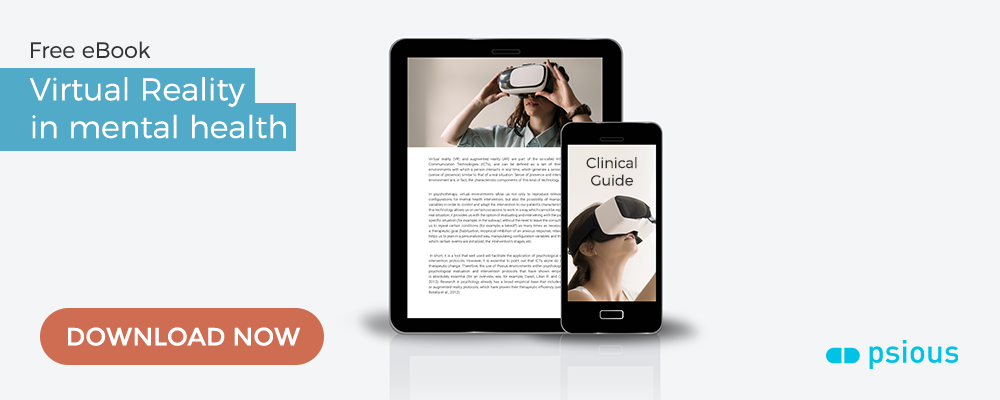VR and the “digital natives”
VR is one of the ICTs (Information and Communication Technologies) that is gaining space in the health and education sector.Although there are still those who doubt its effectiveness, the empirical evidence shows that its benefits in many areas.The digitalized society we live in requires us to adapt to new technologies and innovations that affect all areas of our lives.In approximately 1981 the generation “Y” began, considered to be the first “digital natives” and called Millennials. The “digital natives” are those who grew up in the digital age along with the development of new technologies and considering themselves very familiar with them.That also means that Millennials, in addition to handling tools more easily than previous generations, consider new technologies attractive and facilitating at the same time.It is no coincidence that children, youth and young adults are currently attracted by the possibility of using Virtual Reality in a therapeutic intervention.
Patients prefer VR interventions
Mindfulness techniques have shown to have benefits for ADHD patients. Many studies support the effectiveness of virtual reality in ADHD intervention (Didonna, F., 2011; Hodann-Caudevilla, RM, & Serrano-Pintado, I. , 2016; Serra-Pla, J. et al, 2017; González-García, M., & González López, J, 2017; Ruskin, DA et al., 2017; Sanger, KL et al., 2018; Navarro-Haro , MV et al., 2019).In a study from Sant Joan De Déu Hospital in Barcelona, Psious’ virtual reality was used for intervention and it showed interesting results. 87 children between 7 and 12 years old with ADHD took part in the research, and the results showed that 91% of children preferred to be assigned to the Mindfulness group through VR, than the group that used Mindfulness techniques in a traditional way.A study by Amanda A. Benbow and Page L. Anderson comparing the dropout ratio between the use of in vivo and the VR therapy for the treatment of anxiety disorders points to a higher dropout rate of in vivo exposure. This is because many patients feel uncomfortable and are afraid of exposing themselves to phobic stimulation. With the possibility to choose between techniques, the majority of patients would choose VRET compared to in vivo exposure (Garcia-Palacios, Hoffman, KwongSee, Tsai, & Botella, 2001; García-Palacios, Botella, Hoffman, & Fabregat , 2007; cited in Amanda A. Benbow & Page L. Anderson, 2019).In 2007, García-Palacios et al. studied the acceptance and rejection between in vivo exposure and the use of virtual reality. They concluded that 27% of patients with specific phobias reject the use of in vivo exposure techniques, as they consider it overly intense, while only 3% refused VR exposure.This suggests that virtual reality increases the willingness of patients to seek treatment in order to overcome their anxiety disorders.
Amelia Virtual Care virtual reality
In Amelia Virtual Care we are committed to promoting and continuing to carry out research studies on the use of virtual reality, and continuing to develop new environments for intervention for many health conditions.Currently, we have more than 70 virtual environments that are adaptable to the needs of each patient, supporting the intervention of multiple conditions, and enabling the application of different techniques such as exposure, systematic desensitization, diaphragmatic breathing, muscle relaxation, visualization/imagery, mindfulness and EMDR in the privacy of the therapist’s consultation.
Bibliografia
- Didonna, F. (2011). Introducción: Donde convergen los nuevos y los viejos caminos para tratar el sufrimiento. Manual Clínico de Mindfulness, pag. 537-568
- Hodann-Caudevilla, R. M., & Serrano-Pintado, I. (2016). Systematic review of the efficacy of mindfulness-based therapy for anxiety disorders. Ansiedad y Estrés. https://doi.org/10.1016/j.anyes.2016.04.001
- Serra-Pla, J. F., Pozuelo, M., Richarte, V., Corrales, M., Ibanez, P., Bellina, M., … Ramos-Quiroga, J. A. (2017). [Treatment of attention deficit hyperactivity disorder in adults using virtual reality through a mindfulness programme]. Revista de Neurologia, 64(s01), S117–S122. Retrieved from http://www.ncbi.nlm.nih.gov/pubmed/28256698
- González-García, M., & González López, J. (2017). Bases neurofisiológicas de mindfulness y compasión: una propuesta desde la teoría polivagal. Mindfulness & Compassion, 2(2), 101–111. https://doi.org/https://doi.org/10.1016/j.mincom.2017.09.002
- Ruskin, D. A., Gagnon, M. M., Kohut, S. A., Stinson, J. N., & Walker, K. S. (2017). A Mindfulness Program Adapted for Adolescents With Chronic Pain. The Clinical Journal of Pain, 33(11), 1019–1029. https://doi.org/10.1097/AJP.0000000000000490
- Sanger, K. L., Thierry, G., & Dorjee, D. (2018). Effects of school-based mindfulness training on emotion processing and well-being in adolescents: evidence from event-related potentials. Developmental Science, e12646. https://doi.org/10.1111/desc.12646
- Navarro-Haro, M. V., Modrego-Alarcón, M., Hoffman, H. G., López-Montoyo, A., Navarro-Gil, M., Montero-Marin, J., … García-Campayo, J. (2019). Evaluation of a Mindfulness-Based Intervention With and Without Virtual Reality Dialectical Behavior Therapy® Mindfulness Skills Training for the Treatment of Generalized Anxiety Disorder in Primary Care: A Pilot Study. Frontiers in Psychology, 10(January). https://doi.org/10.3389/fpsyg.2019.00055
- Kabat-Zinn J: Mindfulness for All: The Wisdom to Transform the World. NY: Hachette; 2019.
- Huguet, A. & Alda, Jose A. Realidad virtual (RV) como estrategia de intervención innovadora: mindfulness mediante RV en niños con TDAH. Oral communication at the 62º Congreso de AEPNYA, 7-9 de Junio 2017, Palma de Mallorca.
- Huguet, A., Alda, Jose A., Chamorro, M., Gelabert, JM. y Insa, I. Mindfulness mediante realidad virtual en niños recientemente diagnosticados de TDAH versus programa de mindfulness estándar .Poster at the 63º Congreso de AEPNYA, 2019, Oviedo.
- Huguet, A., Alda, Jose A., Insa, I & Gelabert, JM. Treatment of attention deficit hyperactivity disorder in children using mindfulness and virtual reality. Oral communication at the European Society for Child and Adolescent Psychiatry 30 June-2 July 2019, Viena.
- Amanda A. Benbow, Page L. Anderson (2019). A meta-analytic examination of attrition in virtual reality exposure therapy for anxiety disorders. Journal of Anxiety Disorders 61, 18-26.
- Helene S. Wallach, Marilyn Phyllis Safir and Margalit Bar-Zvi (2009). Virtual Reality Cognitive Behavior Therapy for public speaking anxiety: A randomized clinical trial. Sage Publications, Vol 33, N 3, 314-338.
- García-Palacios, A., Botella, C., Hoffman, H., Fabregat, S. (2007). Comparing acceptance and refusal rates of virtual reality exposure vs. in vivo exposure by patients with specific phobias. Cyberpsychology & Behavior, 10(5), 722-724.













